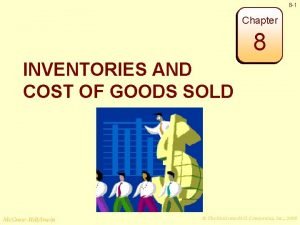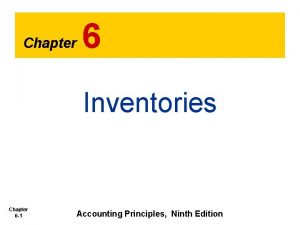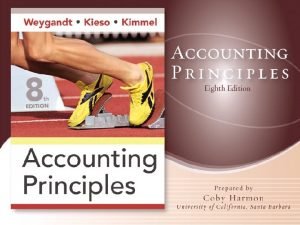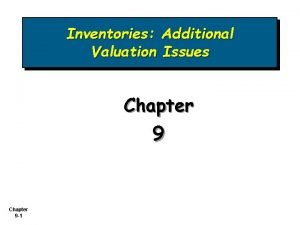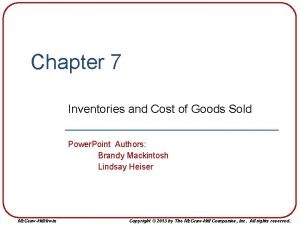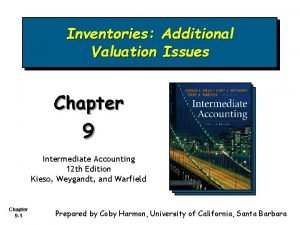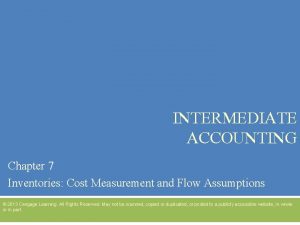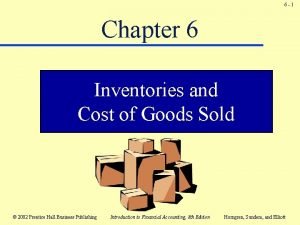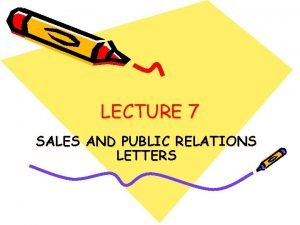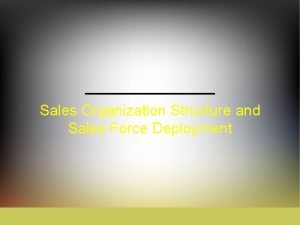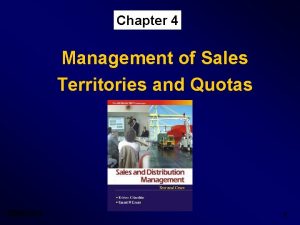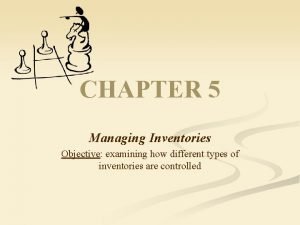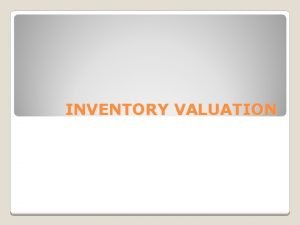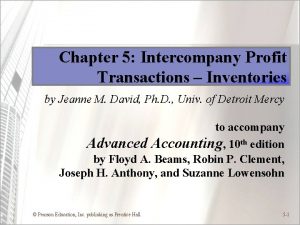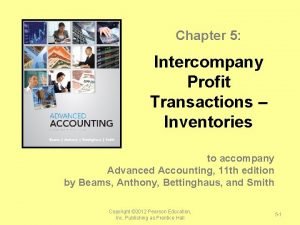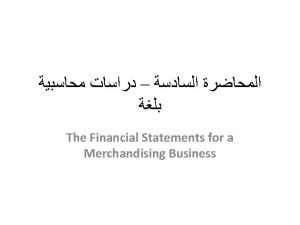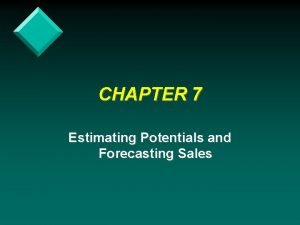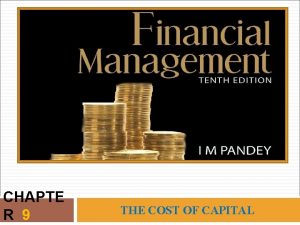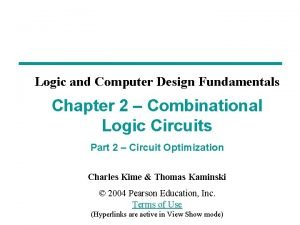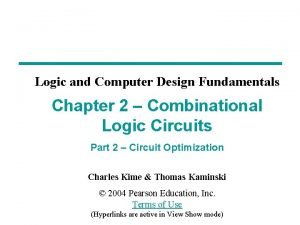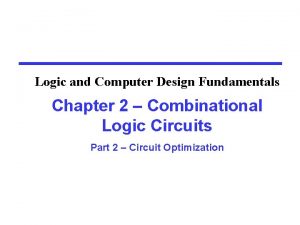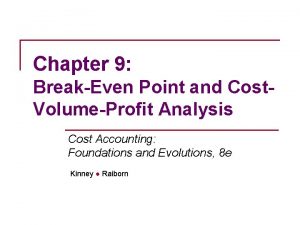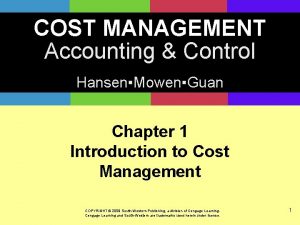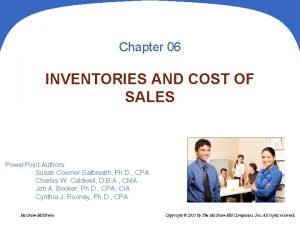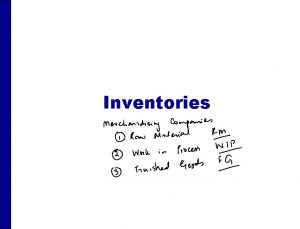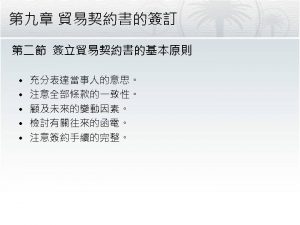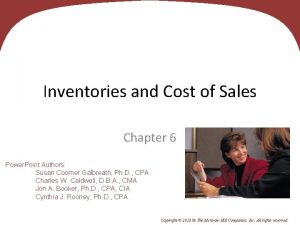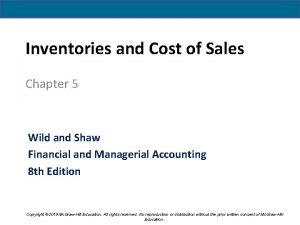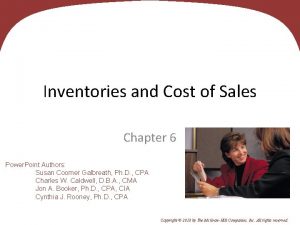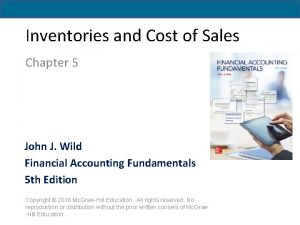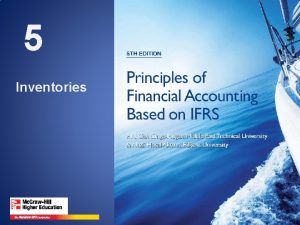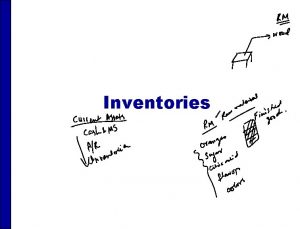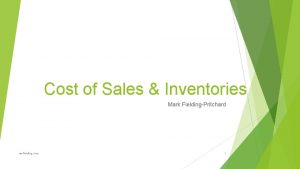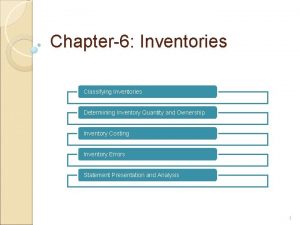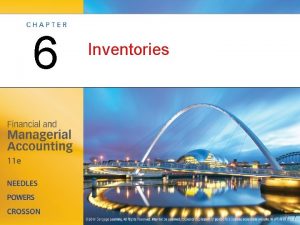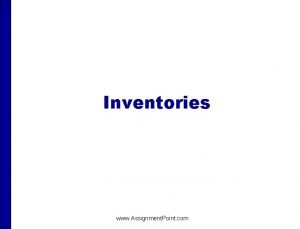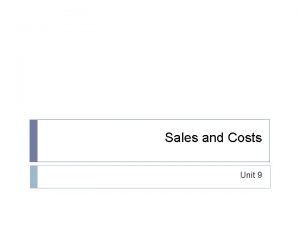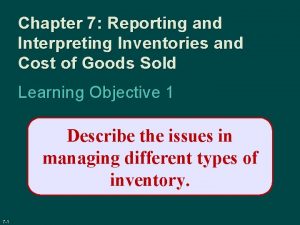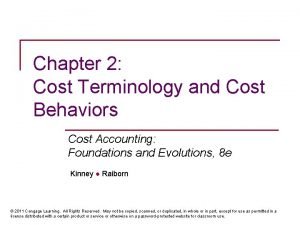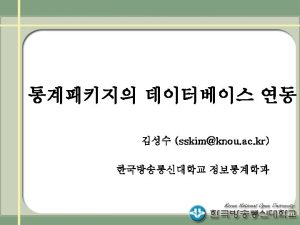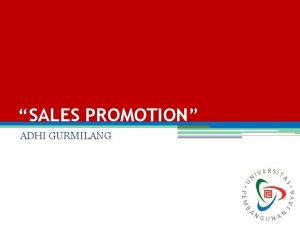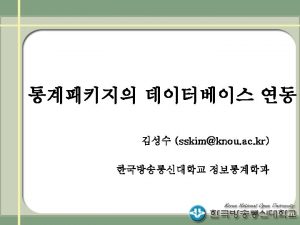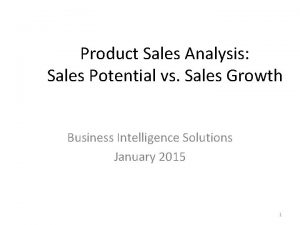Inventories and Cost of Sales Chapter 6 Power



























































- Slides: 59

Inventories and Cost of Sales Chapter 6 Power. Point Editor: Beth Kane, MBA, CPA Wild, Shaw, and Chiappetta Fundamental Accounting Principles 22 nd Edition Copyright @ 2015 Mc. Graw Hill Education. All rights reserved. No reproduction or distribution without the prior written consent of Mc. Graw-Hill Education.

06 -C 1: Determining Inventory Items 2

6 -3 Determining Inventory Items Merchandise inventory includes all goods that a company owns and holds for sale, regardless of where the goods are located when inventory is counted. Items requiring special attention include: Goods in Transit C 1 Goods on Consignment Goods Damaged or Obsolete 3

6 -4 Goods in Transit FOB Shipping Point Public Carrier Seller Buyer Ownership passes to the buyer here. Public Carrier Seller C 1 FOB Destination Point Buyer 4

6 -5 Goods on Consignment Merchandise is included in the inventory of the consignor, the owner of the inventory. C 1 5

6 -6 Goods Damaged or Obsolete Damaged or obsolete goods are not counted in inventory if they cannot be sold. Cost should be reduced to net realizable value if they can be sold. C 1 6

06 -C 2: Determining Inventory Costs 7

6 -8 Determining Inventory Costs Include all expenditures necessary to bring an item to a salable condition and location. Minus Discounts and Allowances Plus Import Duties C 2 Invoice Cost Plus Freight Plus Insurance Plus Storage 8

6 -9 Internal Controls and Taking a Physical Count Ø Most companies take a physical count of inventory at least once each year. Ø When the physical count does not match the Merchandise Inventory account, an adjustment must be made. Good internal controls over count include: 1. Pre-numbered inventory tickets. 2. Counters have no inventory responsibility. 3. Counts confirm existence, amount, and quality of inventory item. 4. Second count is taken. 5. Manager confirms all items counted. C 2 9

6 - 10 Inventory Costing under a Perpetual System Inventory affects. . . Balance Sheet Income Statement The matching principle requires matching costs with sales. C 2 10

6 - 11 Inventory Cost Flow Assumptions Management decisions in accounting for inventory involve the following: 1. Items included in inventory and their costs. 2. Costing method (specific identification, FIFO, LIFO, or weighted average). 3. Inventory system (perpetual or periodic). 4. Use of market values or other estimates. C 2 11

NEED-TO-KNOW A master carver of wooden birds operates her business out of a garage. At the end of the current period, the carver has 17 units (carvings) in her garage, three of which were damaged by water and cannot be sold. The distributor also has another five units in her truck, ready to deliver per a customer order, terms FOB destination, and another 11 units out on consignment at several small retail stores. How many units does the carver include in the business’s period-end inventory? Units in ending inventory Key point – How many units does she own at year-end? Units in storage 17 Less damaged (unsalable) units (3) Plus units in transit (FOB Destination) 5 Plus units on consignment 11 Total units in ending inventory 30 A distributor of artistic iron-based fixtures acquires a piece for $1, 000, terms FOB shipping point. Additional costs in obtaining it and offering it for sale include $150 for transportation-in, $300 for import duties, $100 for insurance during shipment, $200 for advertising, a $50 voluntary gratuity to the delivery person, $75 for enhanced store lighting, and $250 for sales staff salaries. For computing inventory, what cost is assigned to this artistic piece? Cost of inventory Key point – What are the necessary costs to get the asset ready for its intended purpose? Cost Transportation-in (FOB shipping point) Import duties Insurance cost Inventory cost Copyright © 2015 Mc. Graw-Hill Education $1, 000 150 300 100 $1, 550

06 -P 1: Inventory Costing 13

6 - 14 Inventory Cost Flow Assumptions P 1 First-In, First-Out (FIFO) Assumes costs flow in the order incurred. Last-In, First-Out (LIFO) Assumes costs flow in the reverse order incurred. Weighted Average Assumes costs flow at an average of the costs available. 14

6 - 15 Inventory Costing Illustration Here is information about the mountain bike inventory of Trekking for the month of August. P 1 15

6 - 16 Specific Identification P 1 16

6 - 17 First-In, First-Out (FIFO) P 1 Oldest Costs Cost of Goods Sold Recent Costs Ending Inventory 17

6 - 18 First-In, First-Out (FIFO) P 1 18

6 - 19 Last-In, First-Out (LIFO) P 1 Recent Costs Cost of Goods Sold Oldest Costs Ending Inventory 19

6 - 20 Last-In, First-Out (LIFO) P 1 20

6 - 21 Weighted Average When a unit is sold, the average cost of each unit in inventory is assigned to cost of goods sold. Cost of Goods Available for Sale P 1 ÷ Units on hand on the date of sale 21

6 - 22 Weighted Average P 1 22

NEED-TO-KNOW A company reported the following December purchases and sales data for its only product. Date Dec. 01 Dec. 08 Dec. 09 Dec. 19 Dec. 24 Dec. 30 Activities Beginning inventory Purchase Sales Purchase Units Acquired at Cost Units Sold at Retail 5 units @ $3. 00 = $15. 00 10 units @ $4. 50 = $45. 00 8 units @ $7. 00 13 units @ $5. 00 = $65. 00 18 units @ $8. 00 8 units @ $5. 30 = $42. 40 36 units $167. 40 26 units The company uses a perpetual inventory system. Determine the cost assigned to ending inventory and to cost of goods sold using (a) specific identification, (b) FIFO, (c) LIFO, and (d) weighted average. (Round per unit costs and inventory amounts to cents. ) For specific identification, ending inventory consists of 10 units, where eight are from the December 30 purchase and two are from the December 8 purchase. P 1 23

NEED-TO-KNOW A company reported the following December purchases and sales data for its only product. Date Dec. 01 Dec. 08 Dec. 09 Dec. 19 Dec. 24 Dec. 30 Activities Units Acquired at Cost Beginning inventory 5 units @ $3. 00 = $15. 00 Purchase 10 units @ $4. 50 = $45. 00 Sales Purchase 13 units @ $5. 00 = $65. 00 Sales Purchase 8 units @ $5. 30 = $42. 40 36 units $167. 40 Units Sold at Retail 8 units @ $7. 00 18 units @ $8. 00 26 units The company uses a perpetual inventory system. Determine the cost assigned to ending inventory and to cost of goods sold using (a) specific identification, (b) FIFO, (c) LIFO, and (d) weighted average. (Round per unit costs and inventory amounts to cents. ) For specific identification, ending inventory consists of 10 units, where eight are from the December 30 purchase and two are from the December 8 purchase. Regardless of the method used, the cost of 26 units are included in Cost of Goods Sold, and the cost of 10 units are included in Ending Inventory P 1 24

NEED-TO-KNOW A company reported the following December purchases and sales data for its only product. Date Dec. 01 Dec. 08 Dec. 09 Dec. 19 Dec. 24 Dec. 30 Activities Units Acquired at Cost Beginning inventory 5 units @ $3. 00 = $15. 00 Purchase 10 units @ $4. 50 = $45. 00 Sales Purchase 13 units @ $5. 00 = $65. 00 Sales Purchase 8 units @ $5. 30 = $42. 40 36 units $167. 40 Units Sold at Retail 8 units @ $7. 00 18 units @ $8. 00 26 units The company uses a perpetual inventory system. Determine the cost assigned to ending inventory and to cost of goods sold using (a) specific identification, (b) FIFO, (c) LIFO, and (d) weighted average. (Round per unit costs and inventory amounts to cents. ) For specific identification, ending inventory consists of 10 units, where eight are from the December 30 purchase and two are from the December 8 purchase. Specific Identification Method Not an inventory assumption - Actual Cost of Goods Sold represents the actual cost of the units selected by the customer. Ending Inventory represents the actual cost of the units that remain in ending inventory. P 1 25

NEED-TO-KNOW Date Dec. 01 Dec. 08 Dec. 09 Dec. 19 Dec. 24 Dec. 30 Activities Units Acquired at Cost Beginning inventory 5 units @ $3. 00 = $15. 00 Purchase 10 units @ $4. 50 = $45. 00 Sales 13 units @ $5. 00 = $65. 00 Purchase Sales Purchase 8 units @ $5. 30 = $42. 40 36 units $167. 40 Units Sold at Retail 8 units @ $7. 00 18 units @ $8. 00 26 units Ending inventory consists of 10 units, where eight are from the December 30 purchase and two are from the December 8 purchase. Specific Identification – Cost of exact units sold are expensed as Cost of Goods Sold. Date Dec. 01 Dec. 08 Dec. 19 Dec. 30 Activities Beginning inventory Purchase Cost of Goods Sold Ending inventory Goods available for sale P 1 Units Acquired at Cost 5 @ $3. 00 = $15. 00 10 @ $4. 50 = $45. 00 13 @ $5. 00 = $65. 00 8 @ $5. 30 = $42. 40 36 units $167. 40 Cost of Goods Sold 5 @ $3. 00 = $15. 00 8 @ $4. 50 = $36. 00 13 @ $5. 00 = $65. 00 26 units $116. 00 Cost of Ending Inventory 2 @ $4. 50 = $9. 00 8 @ $5. 30 = $42. 40 10 units $51. 40 $116. 00 51. 40 $167. 40 26

NEED-TO-KNOW Date Dec. 01 Dec. 08 Dec. 09 Dec. 19 Dec. 24 Dec. 30 Activities Units Acquired at Cost Beginning inventory 5 units @ $3. 00 = $15. 00 Purchase 10 units @ $4. 50 = $45. 00 Sales 13 units @ $5. 00 = $65. 00 Purchase Sales Purchase 8 units @ $5. 30 = $42. 40 36 units $167. 40 Units Sold at Retail 8 units @ $7. 00 18 units @ $8. 00 26 units Perpetual FIFO – Cost of Goods Sold is calculated at the time of the sale. The first items in are the first items out – expensed as Cost of Goods Sold. Date Dec. 1 Dec. 8 Goods Purchased 10 @ $4. 50 Dec. 9 Dec. 19 5 @ $3. 00 3 @ $4. 50 P 1 } = $28. 50 13 @ $5. 00 Dec. 24 Dec. 30 Cost of Goods Sold 7 @ $4. 50 11 @ $5. 00 } = $86. 50 8 @ $5. 30 Cost of Goods Sold $115. 00 Ending inventory 52. 40 Goods available for sale $167. 40 Inventory Balance 5 @ $3. 00 = $15. 00 5 @ $3. 00 } = $60. 00 10 @ $4. 50 7 @ $4. 50 13 @ $5. 00 2 @ $5. 00 8 @ $5. 30 = $31. 50 } = $96. 50 = $10. 00 } = $52. 40 $115. 00 27

NEED-TO-KNOW Date Dec. 01 Dec. 08 Dec. 09 Dec. 19 Dec. 24 Dec. 30 Activities Units Acquired at Cost Beginning inventory 5 units @ $3. 00 = $15. 00 Purchase 10 units @ $4. 50 = $45. 00 Sales 13 units @ $5. 00 = $65. 00 Purchase Sales Purchase 8 units @ $5. 30 = $42. 40 36 units $167. 40 Units Sold at Retail 8 units @ $7. 00 18 units @ $8. 00 26 units Perpetual LIFO – Cost of Goods Sold is calculated at the time of the sale. The last items in are the first items out – expensed as Cost of Goods Sold. Date Dec. 1 Dec. 8 Goods Purchased 10 @ $4. 50 Dec. 9 Dec. 19 8 @ $4. 50 P 1 = $36. 00 13 @ $5. 00 Dec. 24 Dec. 30 Cost of Goods Sold } 3 @ $3. 00 2 @ $4. 50 13 @ $5. 00 } = $83. 00 8 @ $5. 30 Cost of Goods Sold Ending inventory Goods available for sale Inventory Balance 5 @ $3. 00 = $15. 00 5 @ $3. 00 } = $60. 00 10 @ $4. 50 5 @ $3. 00 } = $24. 00 2 @ $4. 50 5 @ $3. 00 2 @ $4. 50 = $89. 00 13 @ $5. 00 2 @ $3. 00 = $6. 00 2 @ $3. 00 8 @ $5. 30 $119. 00 48. 40 $167. 40 } = $48. 40 $119. 00 28

NEED-TO-KNOW Date Dec. 01 Dec. 08 Dec. 09 Dec. 19 Dec. 24 Dec. 30 Activities Units Acquired at Cost Beginning inventory 5 units @ $3. 00 = $15. 00 Purchase 10 units @ $4. 50 = $45. 00 Sales 13 units @ $5. 00 = $65. 00 Purchase Sales Purchase 8 units @ $5. 30 = $42. 40 36 units $167. 40 Units Sold at Retail 8 units @ $7. 00 18 units @ $8. 00 26 units Weighted Average – Cost of Goods Sold is calculated at the time of the sale. Average cost is equal to cost of goods available at the time of the sale divided by number of units available at the time of the sale. Date Goods Purchased Cost of Goods Sold Inventory Balance Dec. 1 5 @ $3. 00 = $15. 00 Dec. 8 10 @ $4. 50 5 @ $3. 00 } = $60. 00 10 @ $4. 50 $60 / 15 units = $4. 00 avg. cost Dec. 9 Dec. 19 8 @ $4. 00 13 @ $5. 00 Dec. 24 Dec. 30 P 1 = $32. 00 18 @ $4. 65 = $83. 70 8 @ $5. 30 Cost of Goods Sold Ending inventory Goods available for sale 7 @ $4. 00 = $28. 00 7 @ $4. 00 } = $93. 00 13 @ $5. 00 $93 / 20 units = $4. 65 avg. cost 2 @ $4. 65 = $9. 30 2 @ $4. 65 } = $51. 70 8 @ $5. 30 $51. 70 / 10 units = $5. 17 avg. cost $115. 70 51. 70 $167. 40 $115. 70 29

06 -A 1: Financial Statement Effects of Costing Methods 30

6 - 31 Financial Statement Effects of Costing Methods Because prices change, inventory methods nearly always assign different cost amounts. A 1 31

6 - 32 Financial Statement Effects of Costing Methods Advantages of Methods First-In, First -Out Last-In, First. Out Weighted Average Ending inventory approximates current replacement cost. Better matches current costs in cost of goods sold with revenues. Smoothes out price changes. A 1

6 - 33 Tax Effects of Costing Methods The Internal Revenue Service (IRS) identifies several acceptable inventory costing methods for reporting taxable income. If LIFO is used for tax purposes, the IRS requires it be used in financial statements. A 1 33

6 - 34 Consistency in Using Costing Methods The consistency principle requires a company to use the same accounting methods period after period so that financial statements are comparable across periods. A 1 34

06 -P 2: Lower of Cost or Market 35

6 - 36 Lower of Cost or Market Inventory must be reported at market value when market is lower than cost. Defined as current replacement cost (not sales price). Consistent with the conservatism principle. P 2 Can be applied three ways: (1) (2) (3) separately to each individual item. to major categories of assets. to the whole inventory. 36

6 - 37 Lower of Cost or Market A motor sports retailer has the following items in inventory: P 2 37

NEED-TO-KNOW A company has the following products in its ending inventory. (a) Compute the lower of cost or market for its inventory when applied separately to each product. (b) If the LCM amount is less than the recorded cost of the inventory, then record the December 31 LCM adjustment to the Merchandise Inventory account. Road bikes Mountain bikes Town bikes Total Date Dec. 31 P 2 Units 5 4 10 Per Unit Cost Market $1, 000 $800 500 600 450 General Journal Cost of Goods Sold Merchandise Inventory Total Cost Market $5, 000 $4, 000 2, 400 4, 000 4, 500 $11, 000 Debit 1, 000 LCM By item $4, 000 2, 000 4, 000 $10, 000 Credit 1, 000 38

06 -A 2: Financial Statement Effects of Inventory Errors 39

6 - 40 Financial Statement Effects of Inventory Errors A 2 40

6 - 41 Financial Statement Effects of Inventory Errors A 2 41

6 - 42 Global View Items and Costs Making Up Inventory Both U. S. GAAP and IFRS include in inventory all items that a company owns and holds for sale plus all cost expenditures necessary to bring those items to a salable condition and location. Assigning Costs to Inventory Both U. S. GAAP and IFRS allow companies to use specific identification, FIFO, and Weighted Average. IFRS does not currently allow use of LIFO. Estimating Inventory Costs Both U. S. GAAP and IFRS require companies to write down inventory when its value falls below recorded cost. U. S. GAAP prohibits any later increase in value. IFRS does allow reversals of write downs up to the original acquisition cost. Neither allow inventory to be adjusted upward beyond the original cost. 42

NEED-TO-KNOW A company had $10, 000 of sales in each of three consecutive years 20 X 1 -20 X 3, and it purchased merchandise costing $7, 000 in each of those years. It also maintained a $2, 000 physical inventory from the beginning to the end of that three-year period. In accounting for inventory, it made an error at the end of year 20 X 1 that caused its year-end 20 X 1 inventory to appear on its statements as $1, 600 rather than the correct $2, 000. (a) Determine the correct amount of the company’s gross profit in each of the years 20 X 1– 20 X 3. (b) Prepare comparative income statements to show the effect of this error on the company’s cost of goods sold and gross profit for each of the years 20 X 1– 20 X 3. Correct Amounts Year 20 X 1 Sales $10, 000 Cost of goods sold Beginning inventory $2, 000 Cost of purchases 7, 000 Goods available for sale 9, 000 Ending inventory 2, 000 Cost of goods sold 7, 000 Gross profit $3, 000 Inventory error Year 20 X 1 Sales $10, 000 Cost of goods sold Beginning inventory $2, 000 Cost of purchases 7, 000 Goods available for sale 9, 000 Ending inventory 1, 600 Cost of goods sold 7, 400 Gross profit $2, 600 A 2 Year 20 X 2 $10, 000 $2, 000 7, 000 9, 000 2, 000 Year 20 X 3 $10, 000 Total $30, 000 $2, 000 7, 000 9, 000 2, 000 7, 000 $3, 000 21, 000 $9, 000 Year 20 X 2 $10, 000 Year 20 X 3 $10, 000 Total $30, 000 $1, 600 7, 000 8, 600 2, 000 $2, 000 7, 000 9, 000 2, 000 6, 600 $3, 400 7, 000 $3, 000 21, 000 $9, 000 43

06 -A 3: Inventory Turnover and Days' Sales in Inventory 44

6 - 45 Inventory Turnover Shows how many times a company turns over its inventory during a period. Indicator of how well management is controlling the amount of inventory available. Inventory turnover Average Inventory A 3 = = Cost of goods sold Average inventory (Beg. Inv. + End Inv. ) ÷ 2 45

6 - 46 Days’ Sales in Inventory Reveals how much inventory is available in terms of the number of days’ sales. Days‘ sales in inventory A 3 = Ending inventory Cost of goods sold × 365 46

06 -P 3: Inventory Costing under a Periodic System 47

6 - 48 Appendix 6 A: Inventory Costing under a Periodic System LIFO computation of COGS and ending inventory under a periodic system. P 3 48

NEED-TO-KNOW A company reported the following December purchases and sales data for its only product. Date Dec. 01 Dec. 08 Dec. 09 Dec. 19 Dec. 24 Dec. 30 Activities Beginning inventory Purchase Sales Purchase Units Acquired at Cost Units Sold at Retail 5 units @ $3. 00 = $15. 00 10 units @ $4. 50 = $45. 00 8 units @ $7. 00 13 units @ $5. 00 = $65. 00 18 units @ $8. 00 8 units @ $5. 30 = $42. 40 36 units $167. 40 26 units The company uses a periodic inventory system. Determine the cost assigned to ending inventory and to cost of goods sold using (a) specific identification, (b) FIFO, (c) LIFO, and (d) weighted average. (Round per unit costs and inventory amounts to cents. ) For specific identification, ending inventory consists of 10 units, where eight are from the December 30 purchase and two are from the December 8 purchase. P 3 49

NEED-TO-KNOW A company reported the following December purchases and sales data for its only product. Date Dec. 01 Dec. 08 Dec. 09 Dec. 19 Dec. 24 Dec. 30 Activities Units Acquired at Cost Beginning inventory 5 units @ $3. 00 = $15. 00 Purchase 10 units @ $4. 50 = $45. 00 Sales Purchase 13 units @ $5. 00 = $65. 00 Sales Purchase 8 units @ $5. 30 = $42. 40 36 units $167. 40 Units Sold at Retail 8 units @ $7. 00 18 units @ $8. 00 26 units The company uses a periodic inventory system. Determine the cost assigned to ending inventory and to cost of goods sold using (a) specific identification, (b) FIFO, (c) LIFO, and (d) weighted average. (Round per unit costs and inventory amounts to cents. ) For specific identification, ending inventory consists of 10 units, where eight are from the December 30 purchase and two are from the December 8 purchase. Regardless of the method used, the cost of 26 units are included in Cost of Goods Sold, and the cost of 10 units are included in Ending Inventory P 3 50

NEED-TO-KNOW A company reported the following December purchases and sales data for its only product. Date Dec. 01 Dec. 08 Dec. 09 Dec. 19 Dec. 24 Dec. 30 Activities Units Acquired at Cost Beginning inventory 5 units @ $3. 00 = $15. 00 Purchase 10 units @ $4. 50 = $45. 00 Sales Purchase 13 units @ $5. 00 = $65. 00 Sales Purchase 8 units @ $5. 30 = $42. 40 36 units $167. 40 Units Sold at Retail 8 units @ $7. 00 18 units @ $8. 00 26 units The company uses a periodic inventory system. Determine the cost assigned to ending inventory and to cost of goods sold using (a) specific identification, (b) FIFO, (c) LIFO, and (d) weighted average. (Round per unit costs and inventory amounts to cents. ) For specific identification, ending inventory consists of 10 units, where eight are from the December 30 purchase and two are from the December 8 purchase. Specific Identification Method Not an inventory assumption - Actual Cost of Goods Sold represents the actual cost of the units selected by the customer. Ending Inventory represents the actual cost of the units that remain in ending inventory. P 3 51

NEED-TO-KNOW Date Dec. 01 Dec. 08 Dec. 09 Dec. 19 Dec. 24 Dec. 30 Activities Units Acquired at Cost Beginning inventory 5 units @ $3. 00 = $15. 00 Purchase 10 units @ $4. 50 = $45. 00 Sales 13 units @ $5. 00 = $65. 00 Purchase Sales Purchase 8 units @ $5. 30 = $42. 40 36 units $167. 40 Units Sold at Retail 8 units @ $7. 00 18 units @ $8. 00 26 units Ending inventory consists of 10 units, where eight are from the December 30 purchase and two are from the December 8 purchase. Specific Identification – Cost of exact units sold are expensed as Cost of Goods Sold. Date Dec. 01 Dec. 08 Dec. 19 Dec. 30 P 3 Activities Beginning inventory Purchase Units Acquired at Cost 5 @ $3. 00 = $15. 00 10 @ $4. 50 = $45. 00 13 @ $5. 00 = $65. 00 8 @ $5. 30 = $42. 40 36 units $167. 40 Cost of Goods Sold 5 @ $3. 00 = $15. 00 8 @ $4. 50 = $36. 00 13 @ $5. 00 = $65. 00 26 units $116. 00 Cost of Ending Inventory 2 @ $4. 50 = $9. 00 8 @ $5. 30 = $42. 40 10 units $51. 40 52

NEED-TO-KNOW Date Dec. 01 Dec. 08 Dec. 09 Dec. 19 Dec. 24 Dec. 30 Activities Units Acquired at Cost Beginning inventory 5 units @ $3. 00 = $15. 00 Purchase 10 units @ $4. 50 = $45. 00 Sales 13 units @ $5. 00 = $65. 00 Purchase Sales Purchase 8 units @ $5. 30 = $42. 40 36 units $167. 40 Units Sold at Retail 8 units @ $7. 00 18 units @ $8. 00 26 units Periodic FIFO – Cost of Goods Sold is calculated at the end of the period. The first items in are the first items out – expensed as Cost of Goods Sold. Date Dec. 01 Dec. 08 Dec. 19 Dec. 30 P 3 Activities Beginning inventory Purchase Units Acquired at Cost 5 @ $3. 00 = $15. 00 10 @ $4. 50 = $45. 00 13 @ $5. 00 = $65. 00 8 @ $5. 30 = $42. 40 36 units $167. 40 Cost of Goods Sold 5 @ $3. 00 = $15. 00 10 @ $4. 50 = $45. 00 11 @ $5. 00 = $55. 00 26 units $115. 00 Cost of Ending Inventory 2 @ $5. 00 = $10. 00 8 @ $5. 30 = $42. 40 10 units $52. 40 53

NEED-TO-KNOW Date Dec. 01 Dec. 08 Dec. 09 Dec. 19 Dec. 24 Dec. 30 Activities Units Acquired at Cost Beginning inventory 5 units @ $3. 00 = $15. 00 Purchase 10 units @ $4. 50 = $45. 00 Sales 13 units @ $5. 00 = $65. 00 Purchase Sales Purchase 8 units @ $5. 30 = $42. 40 36 units $167. 40 Units Sold at Retail 8 units @ $7. 00 18 units @ $8. 00 26 units Periodic LIFO – Cost of Goods Sold is calculated at the end of the period. The last items in are the first items out – expensed as Cost of Goods Sold. Date Dec. 01 Dec. 08 Dec. 19 Dec. 30 P 3 Activities Beginning inventory Purchase Units Acquired at Cost 5 @ $3. 00 = $15. 00 10 @ $4. 50 = $45. 00 13 @ $5. 00 = $65. 00 8 @ $5. 30 = $42. 40 36 units $167. 40 Cost of Goods Sold 5 @ $4. 50 = $22. 50 13 @ $5. 00 = $55. 00 8 @ $5. 30 = $42. 40 26 units $129. 90 Cost of Ending Inventory 5 @ $3. 00 = $15. 00 5 @ $4. 50 = $22. 50 10 units $37. 50 54

NEED-TO-KNOW Date Dec. 01 Dec. 08 Dec. 09 Dec. 19 Dec. 24 Dec. 30 Activities Units Acquired at Cost Beginning inventory 5 units @ $3. 00 = $15. 00 Purchase 10 units @ $4. 50 = $45. 00 Sales 13 units @ $5. 00 = $65. 00 Purchase Sales Purchase 8 units @ $5. 30 = $42. 40 36 units $167. 40 Units Sold at Retail 8 units @ $7. 00 18 units @ $8. 00 26 units Weighted Average – Cost of Goods Sold is calculated at the end of the period. Each unit sold, and each unit in ending inventory is assigned the same cost per unit: the average cost of units available for sale. Date Dec. 01 Dec. 08 Dec. 19 Dec. 30 Activities Beginning inventory Purchase Units Acquired at Cost 5 @ $3. 00 = $15. 00 10 @ $4. 50 = $45. 00 13 @ $5. 00 = $65. 00 8 @ $5. 30 = $42. 40 36 units $167. 40 Cost of goods available for sale Number of units available for sale P 3 Cost of Goods Sold 26 26@units $4. 65 = $120. 90 $167. 40 36 units Cost of Ending Inventory 1010@units $4. 65 = $46. 50 $4. 65 per unit 55

06 -P 4: Inventory Estimation Methods 56

6 - 57 Appendix 6 B: Inventory Estimation Methods Inventory sometimes requires estimation for interim statements or if some casualty such as fire or flood makes taking a physical count impossible. Retail Inventory Method P 4 Gross Profit Method 57

NEED-TO-KNOW Using the retail method and the following data, estimate the cost of ending inventory. Beginning inventory Purchases Sales Beginning inventory Purchases Total merchandise available for sale Less: Sales Ending inventory priced at retail Cost ratio Ending inventory at cost Cost $324, 000 195, 000 Retail $530, 000 335, 000 320, 000 Cost $324, 000 195, 000 $519, 000 Retail $530, 000 335, 000 $865, 000 (320, 000) $545, 000 0. 60 $327, 000 Cost-to-retail ratio Cost of goods available for sale $519, 000 Retail of goods available for sale $865, 000 P 4 0. 60 58

6 - 59 End of Chapter 6 59
 Chapter 8 inventories and the cost of goods sold
Chapter 8 inventories and the cost of goods sold Chapter 6 inventories
Chapter 6 inventories Inventory in the balance sheet
Inventory in the balance sheet Chapter 9 inventories additional valuation issues
Chapter 9 inventories additional valuation issues Cost of good sold formula
Cost of good sold formula Lower-of-cost-or-market
Lower-of-cost-or-market Dollar value lifo
Dollar value lifo Chapter 6 inventories
Chapter 6 inventories Triangle of power
Triangle of power Sales hierarchy structure
Sales hierarchy structure Discuss the nuances of sales letters.
Discuss the nuances of sales letters. Sales deployment
Sales deployment Sales territories and quotas
Sales territories and quotas What is informal assessment
What is informal assessment Non recycled inventory examples
Non recycled inventory examples Wac inventory
Wac inventory Juloidian inventories
Juloidian inventories Abc analysis
Abc analysis Upstream sale of inventory
Upstream sale of inventory Intercompany sales
Intercompany sales Smarter inventories
Smarter inventories A company has sales of 695 000 and cost of goods
A company has sales of 695 000 and cost of goods Sales force composite
Sales force composite Cost accumulation and cost assignment
Cost accumulation and cost assignment Cost accumulation and cost assignment
Cost accumulation and cost assignment Cost pools
Cost pools What is a period cost on the income statement
What is a period cost on the income statement Cost control and cost reduction difference
Cost control and cost reduction difference Characteristics of standard costing
Characteristics of standard costing Distinguish between average cost and marginal cost
Distinguish between average cost and marginal cost Cost control and cost reduction difference
Cost control and cost reduction difference Process costing vs job order costing
Process costing vs job order costing Ordering cost and carrying cost
Ordering cost and carrying cost Trade off and opportunity cost
Trade off and opportunity cost Cost control and cost reduction project report
Cost control and cost reduction project report Cost control and cost reduction project report
Cost control and cost reduction project report Cost structure refers to the relative proportion of
Cost structure refers to the relative proportion of Manufacturing cost vs non manufacturing cost
Manufacturing cost vs non manufacturing cost Process costing definition
Process costing definition Flotation cost in cost of equity
Flotation cost in cost of equity Controllable expenses examples
Controllable expenses examples Manufacturing cost vs non manufacturing cost
Manufacturing cost vs non manufacturing cost Material price variance
Material price variance Book value of debt
Book value of debt Literal cost gate input cost
Literal cost gate input cost Literal cost gate input cost
Literal cost gate input cost Literal cost gate input cost
Literal cost gate input cost Solar power satellites and microwave power transmission
Solar power satellites and microwave power transmission Actual power
Actual power Explain dispersive power of grating
Explain dispersive power of grating How to audit revenue
How to audit revenue Chapter 9 auditing sales and receivables
Chapter 9 auditing sales and receivables Flex28024a
Flex28024a Power of a power property
Power of a power property General power rule
General power rule Power angle curve in power system stability
Power angle curve in power system stability Powerbi in powerpoint
Powerbi in powerpoint Power absorbed or delivered
Power absorbed or delivered Cvp formula accounting
Cvp formula accounting Cost management accounting and control
Cost management accounting and control
